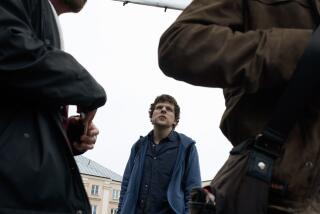David Foster Wallace role finds Jason Segel in his own moment of transition
The role as author David Foster Wallace seems to have come at just the right moment for Jason Segel.
The casting of Jesse Eisenberg as a brainy New York writer-type probably struck no one as a surprise, but from the moment it was first announced to the Sundance premiere, the casting of Segel as a much-cherished literary figure raised many an eyebrow.
Photos that made their way online during production were pored over for hints to his performance. As an article on the website the A.V. Club asked: Would Segel’s performance be Philip Seymour Hoffman as Truman Capote or Ashton Kutcher as Steve Jobs?
SIGN UP for the free Indie Focus movies newsletter >>
“The End of the Tour,” directed by James Ponsoldt from an adaptation by Donald Margulies and just released, stars Segel as Wallace and Eisenberg as writer David Lipsky, based on Lipsky’s book “Although of Course You End Up Becoming Yourself,” which was made up of interviews and conversations between Lipsky and Wallace.
----------
For the record
9:44 a.m., Aug. 2: An earlier version of this article incorrectly rendered the title of David Lipsky’s book “And of Course You End Up Becoming Yourself.” It is “Although of Course You End Up Becoming Yourself.”
----------
In March of 1996, Lipsky had tagged along for the last few days of Wallace’s book tour promoting his monumental novel “Infinite Jest,” a 1,000-plus-page work on tennis, addiction and dystopia. The article the interview was intended for never came out, for varying reasons. Wallace committed suicide in 2008. Lipsky’s book was published in 2010.
For Segel, playing Wallace and the role’s opportunity to meditate on success and its greater meanings has come at an opportune moment. The actor, 35, shot the film immediately after finishing the nine-season run of the television sitcom “How I Met Your Mother.”
In a recent interview in Los Angeles, Segel came across as thoughtful and quietly reflective, taking careful pause to consider what he would say before speaking. The importance of this performance, both in what it means with regards to Wallace and himself, is not lost on him.
“I need to figure out how to phrase this, so it makes total sense, so it expresses what I want to express,” Segel said. “No one took the idea of this needing to be done with empathy and love and great respect and care more seriously than me. Because I was doing it. I guess what was most important to me was that I felt like I did that job. And there are too many people for me to open up the vote.”
For a movie steeped in words — the evolving tension and dynamics conveyed in an inflection or turn of phrase — it may not be a coincidence that both lead actors are also writers themselves. Segel worked on the screenplays for a number of the movies he has starred in, including “Forgetting Sarah Marshall” and “The Muppets,” and recently began publishing a series of books for children.
A native of Los Angeles, Segel began acting as a teenager and first came to wide attention as part of the ensemble on the television show “Freaks and Geeks.” He is now looking to move away from the light, lovable roles in films such as “Sex Tape” or “The Five-Year Engagement,” even if those are roles he had a hand in writing for himself.
To prepare for the Wallace role, Segel listened to recordings of Lipsky’s original interviews with the writer, devoured online footage of the author and even formed a book club to read and discuss ‘“Infinite Jest” with a small circle of what he referred to as “book guys.”
Though “The End of the Tour” will likely always be referred to as “the David Foster Wallace movie,” for Ponsoldt they were decidedly not making a biopic. “Someone can debate that and make it a semantic exercise,” he said, “but I can tell you the people who made the film, speaking for myself, for Donald, for the producers, we wanted it to be an anti-biopic.
“Which is to say most films that are quote-unquote biopics, there are the limitations of a two-hour movie,” he added, “and you have to result to some kind of pop psychology that’s easy, reductive, bullet-pointed, Wikipedia-ed and it just gets psychologically boring and flat. This to me was a very subjective story.”
Coming at his own moment of personal transition, Segel was struck by the way in which the script portrayed Wallace in the same spot, struggling to define his success for himself. While the Lipsky character often looks at Wallace with a mix of admiration and jealousy, Segel’s Wallace in turn regards Lipsky with an air of cautionary warning, to take heed of what you really want.
“There was one line in the script, where as soon as I read it I thought, ‘Yes, I understand this,’” said Segel. “He says something to the effect of, ‘I have to come to terms with the reality that right now I’m 34 years old, alone in a room with a piece of paper.’ And I was like, ‘Yep, I know exactly what you’re talking about.’
“As an actor, as a writer, you’re essentially freelance and you work job to job,” Segel added. “And I had just come to the end of a decadelong run on the TV show and I was starting to grow disinterested with a certain type of material that was readily available to me. So I was going to have to make my way around a very difficult transition to basically starting fresh. And I feel like that’s part of what Wallace was going through.”
Eisenberg has already had experience with movies that interface with relatively recent history. He was nominated for an Academy Award for his portrayal of Facebook cofounder Mark Zuckerberg in “The Social Network” and has specific thoughts of his own regarding how to play a real person.
Segel and Eisenberg met only briefly before shooting began. There wasn’t any time for rehearsal, so their first time acting together was the scene where their two characters meet in the movie. “I’ve never seen somebody so thoughtful and prepared as an actor, who had made such clear decisions,” said Segel. “I learned a lot from watching Jesse act.”
Eisenberg in turn appreciated the approach Segel took to grappling with the well-known public persona of Wallace. “I think he did what I would consider the correct thing, which is serve the story first and the facsimile second,” said Eisenberg. “What he did was create a person who was experiencing real emotions, then surround that person with things that reference that real person, who is iconic, unusual, brilliant but also seemingly very casual about his intelligence.”
Once the film premiered at Sundance, the conversation around Segel’s performance shifted well beyond skepticism. In the New York Times, A.O. Scott wrote of it that “whether it captures the true Wallace or not, [it] is sharp and sensitive, in no small part because it’s modest and appropriately evasive.”
Segel’s career pivot, it seems, has begun.
“I just wanted to find out if I was capable of doing it. That’s the real honest answer,” said Segel. “After years on the TV show and doing these comedies, it wasn’t very challenging and a result you’re not challenging yourself. So it was, ‘If you say you can do this other stuff, let’s find out.’ And that’s what it was, it felt like a very scary test for myself. I feel really satisfied. Honestly.”
Twitter: @IndieFocus
ALSO:
Will ‘The End of the Tour’ warp the way we think about David Foster Wallace?
Review: ‘The End of the Tour’ is a riveting road-trip conversation
More to Read
Only good movies
Get the Indie Focus newsletter, Mark Olsen's weekly guide to the world of cinema.
You may occasionally receive promotional content from the Los Angeles Times.










